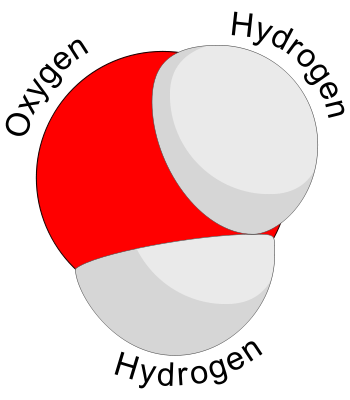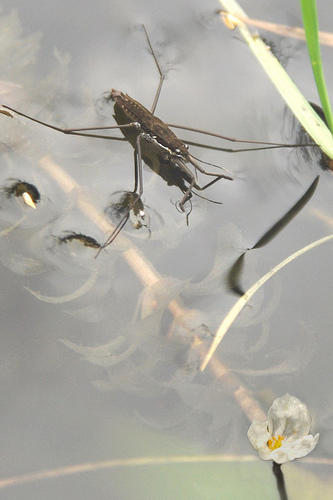VIEW: Properties of Water(BrainPop)
Completion requirements
Properties of Water

A water molecule is made of two hydrogen and one oxygen atom. Image courtesy of Wikimedia.
Water is the only compound that commonly exists in all three states (solid, liquid, gas) on Earth. The unique properties of water are a major factor in the ability of our planet to sustain life. Among water's unique properties is that one side of each water molecule is slightly negative and the other is slightly positive. Individual water molecules, therefore, attract other water molecules like little magnets as the slightly positive portion of a water molecule is attracted to the slightly negative portion of an adjacent water molecule. In this way, water molecules stick together. Water is a polar molecule-- it has electrically charged ends.
Water is composed of two hydrogen atoms and one oxygen atom. Because of this arrangement, water is a polar molecule - one end has a slight negative charge and the other a slight positive charge. This attribute creates an attraction between water molecules, called a hydrogen bond. The hydrogen bond essentially makes water "sticky", allowing water molecules to bond quite easily with each other as well as with other substances. It is this cohesive property of that enables plants to drink (via capillary action, which pulls water from the plants' roots throughout the entire plant), snowflakes to stick together, and insects to walk on water. Another unique property of water is surface tension, or the tightness across the surface of water. This is caused by the polar molecules pulling on each other.

Water's polarity also makes it capable of dissolving many substances. Water is known as a universal solvent because it can dissolve more substances than any other liquid. Many materials are soluble in water, which allows them to be easily dispersed into the environment. Wherever water flows, it takes minerals, nutrients, pollutants, and other chemicals with it. Once chemicals are dissolved in the water they are difficult to remove. This is an important concept when it comes to water pollution and maintaining water quality, as pollutants are very difficult to separate from the water.
Unpolluted water has a pH of 7, which makes it neither acidic nor basic.

Water's cohesiveness due to its polarity allows insects to "walk on water". Photo courtesy of wolfpix/Flickr.
Water's polarity also makes it capable of dissolving many substances. Water is known as a universal solvent because it can dissolve more substances than any other liquid. Many materials are soluble in water, which allows them to be easily dispersed into the environment. Wherever water flows, it takes minerals, nutrients, pollutants, and other chemicals with it. Once chemicals are dissolved in the water they are difficult to remove. This is an important concept when it comes to water pollution and maintaining water quality, as pollutants are very difficult to separate from the water.
Unpolluted water has a pH of 7, which makes it neither acidic nor basic.
After you have completed this part of the lesson, you can check the box for this lesson piece in the course to mark it as complete
Last modified: Monday, 12 February 2018, 12:35 PM